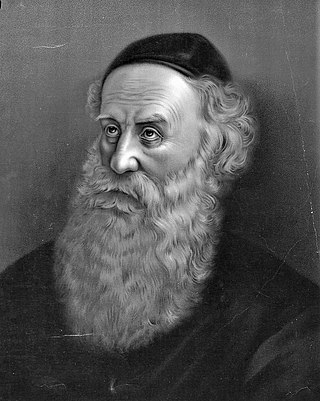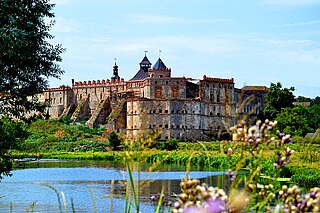Related Research Articles

Adar is the sixth month of the civil year and the twelfth month of the religious year on the Hebrew calendar, roughly corresponding to the month of March in the Gregorian calendar. It is a month of 29 days.

A Rebbe or Admor is the spiritual leader in the Hasidic movement, and the personalities of its dynasties. The titles of Rebbe and Admor, which used to be a general honorific even before the beginning of the movement, became, over time, almost exclusively identified with its Tzadikim.

Shneur Zalman of Liadi, commonly known as the Alter Rebbe or Baal Hatanya, was a rabbi and the founder and first Rebbe of Chabad, a branch of Hasidic Judaism. He wrote many works and is best known for Shulchan Aruch HaRav, Tanya, and his Siddur Torah Or, compiled according to the Nusach Ari.

Dov Ber ben Avraham of Mezeritch, also known as the Maggid of Mezeritch or Mezeritcher Maggid, was a disciple of Rabbi Israel ben Eliezer, the founder of Hasidic Judaism, and was chosen as his successor to lead the early movement. Dov Ber is regarded as the first systematic exponent of the mystical philosophy underlying the teachings of the Baal Shem Tov, and through his teaching and leadership, the main architect of the movement.

Sivan is the ninth month of the civil year and the third month of the religious year on the Hebrew calendar. It is a month of 30 days. Sivan usually falls in May–June on the Gregorian calendar.

Medzhybizh, formerly Mezhybozhe, is a rural settlement in Khmelnytskyi Oblast, western Ukraine. It is located in Khmelnytskyi Raion, 25 kilometres from Khmelnytskyi on the main highway between Khmelnytskyi and Vinnytsia at the confluence of the Southern Buh and Buzhok rivers. Medzhybizh was once a prominent town in the former Podolia Province. Its name is derived from "mezhbuzhye", which means "between the Buzhenka Rivers". It is known as the birthplace of the Jewish Hasidic mystical religious movement. Medzhybizh hosts the administration of Medzhybizh settlement hromada, one of the hromadas of Ukraine. Current population: 1,237 ; 1,731,.
A nigun or niggun is a form of Ashkenazi religious song or tune sung by groups. It is vocal music, often with repetitive sounds such as "Bim-Bim-Bam", "Lai-Lai-Lai", "Yai-Yai-Yai" or "Ai-Ai-Ai" instead of formal lyrics. Sometimes, it is defined as a mysterious musical form of prayer or a spiritual language beyond regular words. Also, Bible verses or quotes from other classical Jewish texts are sometimes sung repetitively to form a nigun. Some nigunim are sung as prayers of lament, while others may be joyous or victorious.
The Sassov Hasidic dynasty began with Rabbi Moshe Leib Erblich of Sassov (1745–1807), a disciple of Rabbi Dovber of Mezeritch, the disciple of the Baal Shem Tov, the founder of Hasidism.

Chernobyl is a Hasidic dynasty which was founded by Grand Rabbi Menachem Nachum Twersky, known by his work as the Meor Einayim. The dynasty is named after the northern Ukrainian city of Chernobyl, where Rabbi Nachum was the maggid. The lineage continues to exist, although not always with the name Chernobyl. Several rebbes are named Chernobyl. The central court is in Bnei Brak, headed by Rabbi Menachem Nachum Twersky.
Devekut, debekuth, deveikuth or deveikus is a Jewish concept referring to closeness to God. It may refer to a deep, trance-like meditative state attained during Jewish prayer, Torah study, or when performing the 613 commandments. It is particularly associated with the Jewish mystical tradition.
The Ozerov Hasidic dynasty is a Hasidic Jewish dynasty founded in 1827 when Yehudah Leib Epstein, rabbi of Ożarów in Poland since 1811, assumed leadership of his Hasidim ("disciples").

Leib Sarah's (1730–1791) was a Chassidic Rebbe and a disciple of the Baal Shem Tov. he (1730-1791) was held in high esteem by the Baal Shem Tov. One of the "hidden righteous," he spent his life wandering from place to place to raise money for the ransoming of imprisoned Jews. (It has been speculated that he is the same person as the shpoler zeide, however that is doubtful as their parents had different names.)

Mezhbizh is the name of the town of Medzhybizh in the present Ukraine which is significant as both the source of a Hasidic dynasty that bears its name and as a symbolic name for the roots of Hasidism.
The following charts illustrate the family of Rabbi Yisrael Baal Shem Tov, the founder of Hasidic Judaism.
Hornosteipel is the name of a Hasidic dynasty founded by Rebbe Yaakov Yisroel Twerski. Hornosteipel is the Yiddish name of Hornostaypil, a town in present-day Ukraine.
Kaliv is a Hasidic dynasty founded by Yitzchak Isaac Taub (1744–1821) of Nagykálló, Hungary.
Israel ben Eliezer 1698 –1760), known as the Baal Shem Tov or BeShT (בעש"ט), was a Jewish mystic and healer who is regarded as the founder of Hasidic Judaism. A baal shem tov is a "Master of the Good Name," that is, one able to work miracles using the secret name of God. Other sources explain his sobriquet as arising from a reputation of being a saintly, or superior, miracle-worker, hence he was given the nickname Baal Shem Tov, that is, the "good Baal Shem".
Rabbi Sholom Shachne of Prohobisht, also known as Rabbi Sholom the Great was a Ukrainian rabbi and father of Rabbi Yisroel Friedman of Ruzhin.

Rabbi David Segal Ha'Levi of Stepin was a disciple of the Baal Shem Tov and the Maggid of Mezeritch.
Rabbi Mordechai of Kremnitz was a Hasidic rabbi in the city of Kremenets. He is considered by some to be one of the greatest rebbes of his generation.
References
- ↑ "Aryeh Leib of Shpola | Encyclopedia.com". www.encyclopedia.com. Retrieved 2022-01-22.
- ↑ https://www.chabad.org/therebbe/article_cdo/aid/6034/jewish/Hayom-Yom-Tevet-14.htm
- ↑ https://www.chabad.org/multimedia/music_cdo/aid/140712/jewish/Kol-Bayaar.htm
- ↑ https://shpolerzaide.files.wordpress.com/2014/02/megilas-yud-tes-shvat.pdf